Adobe Premiere Pro: Lots More than Elements
Last December I shared with you my experience with Adobe's Premiere Elements, which is both an amazingly able application considering its price and an application that's surprisingly easy to use. The next step up the ladder is a huge step on a giant ladder: Adobe Premiere Pro brings broadcast-studio power to your desktop. The price is professional. The system requirements are professional. And the results, if you know what you're doing, will be professional.
And there's the rub. I'm not a television production professional. I had some classes in television production at Ohio State in the 1960s and I produced and directed a couple of industrial videos in the 1980s. But today's video scene has about as much in common with 1980s video as a Lamborghini has in common with a Model-A Ford.
In the old days, we didn't have video tape recorders in the studio. If we wanted to record something, we had to depend on the WOSU-TV staff to roll tape for us. Cameras were mounted on huge, heavy dollys that weighed about 300 pounds. The control room had no way to see the studio floor.
So I remember times when we proceeded with a video production, thinking that tape was rolling and it wasn't.
And I remember discussions such as this:
Me: Camera 2, truck left.
Camera 2: (no response)
Me: Camera 2, truck left!
Camera 2: (no response)
Me:
Camera 2, hello. Please truck left!!!!
Camera 2: (no response)
Me: Camera 1, please tell camera 2 to truck left.
Camera 1 (whispering to Camera 2): Hey! Truck left!
Camera then 2 trucks left about 30 seconds too late.
What I remember most about television from the 1960s is how difficult television was compared to radio. In radio, we could have an idea, write it, voice it, produce it, and have it on the air in just a few minutes. Television production required more people and much more time. But the desktop computer has changed all that, just as it has changed print production, which was another slow process in the good old days. Between about 1967 and now, I've generally avoided TV production because I considered it to be too much of a drag. With tools such as Adobe Premiere CS5, I may not be able to claim that much longer.
Things have changed. Tape is no longer the medium of choice for video. Just about anybody can afford equipment that will record high-definition video. And editing no longer requires a $500-per-hour production suite and half a dozen high-priced technicians.
The desktop computer brings all of this within reach of the average person and the video components of Adobe CS5 make it possible for anyone to create video that's nearly equal in production value to anything network producers create.
It's not just the tools, of course. They're powerful, but they're not magic. You still need to learn about production techniques, master the concepts involved in production, and understand production values, but the average person can do this.
Lynda.com offers numerous classes on how to use the tools, including Premiere Pro CS5 Essential Training by Chad Perkins and Premiere Pro CS5 New Features by Jeff Sengstack.
Video basics start with understanding the various formats. It used to be that video was video. NTSC (National Television System Committee) standards controlled everything even though most television engineers referred to NTSC as "never twice the same color". The standards developed in 1941 are still with us but high definition (HD) video has been added and HD brings its own wide array of variations. Here's Chad Perkins describing the smorgasbord that is video standards:
Rules of the Road
I'm not a graphic designer, but I'm fairly good when it come to avoiding the creation of something ugly. In other words, my designs may not be inspiring, but they're not abominable. This holds true with my video work, too. I'll never win an award for any of my video work, but I've avoided doing anything outlandishly bad.
A few general rules apply to workmanlike video editing.
Rule #1: It's video, so show it instead of talking about it.
Instead of talking heads telling the viewer what's going on, show the viewer what's going on and allow the video to support the message.
Rule #2: Lead with audio.
If a train is about to roll into the scene, let's hear the train before we see it. This is a production value that goes back early in the 20th century for films and has always been a pilar of television production.
Rule #3: Use dissolve transitions unless you know why something else is better.
Three basic options exist for transitions from one scene to another: Cut, dissolve, and fade through black (or white). Cuts are quick and signal that you haven't moved in time or space. Dissolves and fades indicate a more significant change. Premiere offers a huge variety of wipes, but it's essential to understand that these should not be used if you can't state in just a few words what message the wipe is intended to deliver.
Rule #4: Pay attention to the audio (Foley)
"Foley" refers to the process of recording sound effects that are are added in post production to enhance the quality of audio for films, television, video, video games, and radio. The name comes from Jack Foley, who started working with Universal Studios in 1914. Movies were silent then, but as talkies came in, Foley developed techniques that converted Show Boat from a silent move to a musical. Make sure that you have enough live (ambient) audio that you can lay in behind the scenes.
Rule #5: Stop zooming and moving the camera! I'm already sea-sick!
Or is that see-sick? Once upon a time, cameras had fixed lenses so zooming wasn't possible. In the old days, cameras with fixed-length lenses were mounted on 300-pound dollies. Then came zoom lenses and lighter cameras. Now it's easy to pan, tilt, truck, dolly, pedestal, and zoom simultaneously. It's important to remember that the camera represents the audience's point of view.
Cinematography can use a camera that moves and the movement plays a considerable role in the emotional language of film images. Techniques range from the most basic movements of panning (horizontal shift in viewpoint from a fixed position; like turning your head side-to-side) and tilting (vertical shift in viewpoint from a fixed position; like tipping your head back to look at the sky or down to look at the ground) to dollying (placing the camera on a moving platform to move it closer or farther from the subject), tracking [also called trucking] (placing the camera on a moving platform to move it to the left or right), craning (moving the camera in a vertical position; being able to lift it off the ground as well as swing it side-to-side from a fixed base position), and combinations of the above. And, of course, zooming in or out using the lens.
Just because you can do these things doesn't mean that you should and it certainly doesn't mean that you should use all of them non-stop. But here's an amusing effect you can try: Use the lens to zoom out as you move the camera closer to the subject.
Rule#6: If you're editing to audio, match the beats.
Simply put: The process will look more natural if you cut the video on the beat. Undoubtedly there are good sociological, physiological, and psychological reasons why this works. I don't know what any of them are but I do know that it works.
All of these "rules" can be broken to accomplish a specific goal. As with most other endeavors in life, learning the rules is part of the process that imparts the knowledge you need to understand when and how the rules can be ignored.
Looking Behind the Scenes
Video editing can be accomplished on a system with a single monitor, but Premiere has so many control points that you'll enjoy the process more if you use one screen for the various video components and maybe the major control points (the timeline, for example) and a second monitor for the secondary controls and the informational panels that are needed but that need not be in your face at all times. Here's some of what you'll find in Premiere and, if you compare these screens to what I showed in a review of Adobe Premiere Elements (In December We Think of Video), you'll understand just how much more there is to work with here.
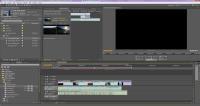 The panel on the left contains resources to be used in the current video: Video, audio, titles, and other components that have been imported. On the right, you see virtual monitors that show the start and end points for a cross-fade between two scenes. At the bottom of the screen, the effects browser is on the left and the sequence timeline is on the right. This timeline shows three video channels and their matching audio channels, but you can add more if you need them. The video channel at the top is the one that's visible unless you turn it off, make it transparent, or mask part of it so that the channels behind it are visible.
The panel on the left contains resources to be used in the current video: Video, audio, titles, and other components that have been imported. On the right, you see virtual monitors that show the start and end points for a cross-fade between two scenes. At the bottom of the screen, the effects browser is on the left and the sequence timeline is on the right. This timeline shows three video channels and their matching audio channels, but you can add more if you need them. The video channel at the top is the one that's visible unless you turn it off, make it transparent, or mask part of it so that the channels behind it are visible.
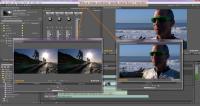 This is a good example of why you need more than one screen! I have the audio mixer up in back and in front there's a multi-camera view and a reference monitor. The project is part of a training program from Lynda.com.
This is a good example of why you need more than one screen! I have the audio mixer up in back and in front there's a multi-camera view and a reference monitor. The project is part of a training program from Lynda.com.
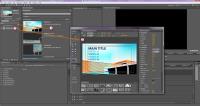 Premiere has some built-in titles that you can start with and modify to suit your needs.
Premiere has some built-in titles that you can start with and modify to suit your needs.
- Start by selecting the overall title you want.
- Add it to a sequence.
- Add, change, or delete the text.
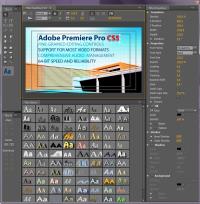 As with other video effects, titling should generally be done simply with basic sans-serif text. And as with the other video effects, Adobe Premiere offers a wide range of text colors and styles (and you can modify them or create your own) for those times when something a bit more flamboyant is called for.
As with other video effects, titling should generally be done simply with basic sans-serif text. And as with the other video effects, Adobe Premiere offers a wide range of text colors and styles (and you can modify them or create your own) for those times when something a bit more flamboyant is called for.
 Bottom Line: Professional video production on your desktop.
Bottom Line: Professional video production on your desktop.
Adobe Premiere Pro earns a cautious 5 cats, but then cats are always cautious except when they dash about without concern for themselves or your antiques. The caution is this: Premiere Pro is designed for professional video editors who have the time, interest, and background in understanding how the various bits work. That's not to say that it's a secret society; anyone can learn how to use Premiere Pro, but it will involve just that: Learning. If you're not willing to take the time to master a highly complex tool, Premiere Elements is what you need.
For more information, visit the Adobe Premiere Pro website. (Or the Adobe Premiere Elements website.)
No Windows 8. Next stop for Microsoft is Windows Y.
The game of one-upping the competition takes a major leap this coming week. Microsoft has announced that it will release an unexpected new version of its Windows operating system on Friday. Possibly taking a swipe at Apple, Microsoft says the new version will be called Windows Y, deftly sidestepping Windows 8, Windows 9, and Windows X.
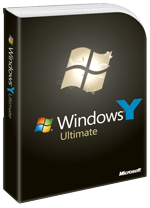 The introduction blind-sided most technology pundits because Microsoft's development team worked under the close direction of the very well respected Norwegian programmer Larsyip Öoldaf.
The introduction blind-sided most technology pundits because Microsoft's development team worked under the close direction of the very well respected Norwegian programmer Larsyip Öoldaf.
In a surprise move, Microsoft announced that Windows Y will be available on new hardware purchased starting at the end of this week. The recommended base configuration is a 64-bit Intel I7 processor, but Microsoft's Öoldaf says Windows Y will run acceptably on any system with at least a 386 processor and 1MB of RAM.
"It's a little slow that way," Öoldaf says, "but our goal was backwards compatibility so that we could reach the large number of computer users who are still running computers that they purchased in 1989." This seemed to be in response to the drubbing Microsoft received for not developing a Windows XP version of Internet Explorer 9, which is due to be released any day now.
For best performance, Windows Y requires 50 gigabytes of RAM and Microsoft recommends a 5-terabyte hard drive because of the size of the application. Windows Y comes on 17 DVDs the basic installation consumes nearly 9 gigabytes of disk space. Those who choose to install the World Language Pack will need at least 23 gigabytes of disk space for the operating system and this could be a problem for the user who tries to install Windows Y on a 386 system with a 20MB hard drive. Öoldaf says disk compression should make it possible to install Windows Y on such a system as long as the user doesn't actually want to install any applications.
The World Language Pack is designed to take input from any form of communication (printed, spoken word, radio, television, and thought patterns) and convert them to the user's language.
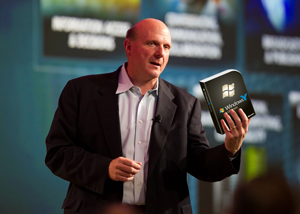 Microsoft's Steve Balmer pointed to PC Magazine bench tests using the Windows Y beta version. The tests show that some basic database tasks, when run on I7 processors, can run to completion a few seconds before they are started. "This is an incredible advance," Balmer said shortly before he began to speak.
Microsoft's Steve Balmer pointed to PC Magazine bench tests using the Windows Y beta version. The tests show that some basic database tasks, when run on I7 processors, can run to completion a few seconds before they are started. "This is an incredible advance," Balmer said shortly before he began to speak.
Apple's Steve Jobs says the name is noteworthy, but "As usual, they got it backwards," Jobs says. "Instead of Windows Y, they should have called it Y Windows. That's what we've been saying for years."
The upgrade is priced at $12, $29, $352, $871, or $5673 depending on the version you choose. For more information on Windows Y, see the Windows Y website.
TechByter Website Moves
The TechByter Worldwide website was unavailable for a few hours during the evening between March 14th and March 15th. Now, although you probably won't notice much of a difference, the site's server is located in a new building. The hosting service I've used for many years is Bluehost in Utah and this move explains why I highly recommend Bluehost to anyone who asks about hosting services.
The company had announced that it was building a new data center and, several days prior to the changeover, I received a message that said construction had been completed on the new data center "with advanced temperature control, custom server racks and dozens of improvements designed to help us provide you with higher quality service. We will be moving all customer servers into the new center over the next few weeks."
The message then provided specific information about this site: "The Bluehost System Administrators will physically move your server into the new data center between 9 PM March 14th and 5 AM March 15th (MDT), during low traffic periods. We will work to ensure you experience as little downtime as possible and, to that end, we will take the opportunity to perform any needed hardware maintenance or upgrades. We expect the process to take 1 to 3 hours."
Bluehost, which was originally located in Orem, Utah, (old time Wordperfect fans will recognize the name of that town) says the expansion places all of the hardware adjacent to the support team and system administrators in Provo, Utah. "Our experience has shown that hands-on control over all aspects of your hosting is the best method of ensuring excellence," the message said.
Bluehost characterizes the changes as a reflection of a continued drive toward security, stability, and reliability. This is simply another example of the reasons that I tell people who are looking for site hosting about Bluehost. You'll find a link to Bluehost near the bottom of most pages on the TechByter Worldwide website.
CEO Matt Heaton cites the data center's network redundancy, with "4 separate physical fibre lines brought into building through two diverse entrances" and also notes that the HVAC system uses outside air more than 7 months per year. Although I've never met Matt, I consider him to be an important business partner.
Short Circuits
Firefox 4 Might Already Be on Your Computer
Firefox can update itself automatically, so my Windows systems already have the newly released version 4. The Linux machine also has version 4, but the process was slightly more involved and I'll describe it next week. HTML5 sites are beginning to show up and Firefox 4 handles them with aplomb.
I've been using the release candidate version for a while and I can tell you that it's fast and reliable. You could synchronize Firefox settings between computers before, but you needed to use an add-on. Now that feature is integrated so that you can synchronize bookmarks, preferences, browser state, and passwords between computers or between a computer and Firefox on your mobile device. Mozilla can host the settings or you can host them yourself. And all of this is optional. If you don't want to sync, don't.
Firefox 4 enhances version 3's private browsing features and now has a "do not track" function that is, as you probably suspected, not compatible with Microsoft's similarly named option.
Firefox 4 loses the Status Bar that used to be at the bottom of the browser. This is where the browser used to show an address when you hovered the mouse over a link. Now the address floats at the bottom of the page when it's needed and disappears when it's not needed. Possibly my favorite new feature is the ability to place the tabs at the top of the browser instead of being mixed in with other browser bars.
Symantec's Norton Internet Security Bar doesn't work with Firefox 4 even though betas and the release candidate have been available for months. I find that annoying but to be expected from large companies that tend to be too timid to act until someone pushes them.
If you're not already using it, you can download Firefox here.
Manhattan Judge Books Google
Although admitting that Google's plan to digitize out-of-print books could be useful to society, US Circuit Court Judge Denny Chin this week ruled against the proposed settlement of a class-action lawsuit by publishers. The suit, filed in 2005, seeks to prohibit Google from making out-of-print books available.
Chin's ruling said that creation of a universal digital library would benefit many but that Google had copied and digitized printed works without permission. The proposed settlement would have allowed authors and publishers of out-of-print works to opt out of having their works included. The judge at the Federal District Court in Manhattan suggested that the parties investigate an opt-in strategy instead.
Google announced its plans in 2004 and has already scanned and digitized more than 12 million books that are, although no longer in print, still subject to copyright.


 The author's image: It's that photo over at the right. This explains why TechByter Worldwide was never on television, doesn't it?
The author's image: It's that photo over at the right. This explains why TechByter Worldwide was never on television, doesn't it?
